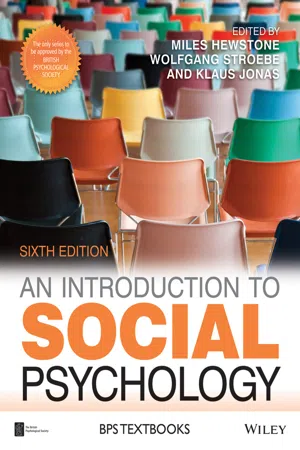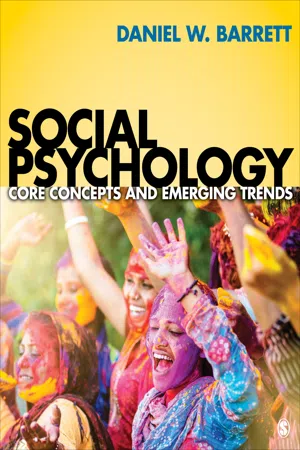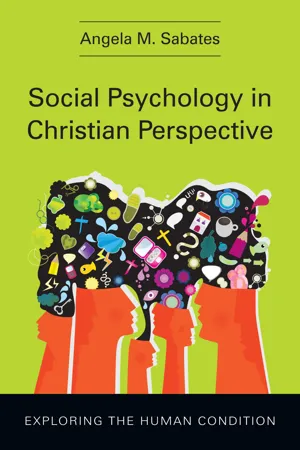Psychology
Social Psychological Explanation of Aggression
The social psychological explanation of aggression focuses on how social factors, such as influence from peers, media, and cultural norms, can contribute to aggressive behavior. It emphasizes the role of social learning, socialization, and situational factors in shaping aggressive tendencies. This perspective highlights the impact of social interactions and environmental influences on the development and expression of aggression.
Written by Perlego with AI-assistance
Related key terms
Related key terms
1 of 4
Related key terms
1 of 3
10 Key excerpts on "Social Psychological Explanation of Aggression"
- eBook - ePub
- Joel Harvey, Derval Ambrose, Joel Harvey, Derval Ambrose(Authors)
- 2022(Publication Date)
- Routledge(Publisher)
Social psychology refers to the examination of human behaviours based on interactions that take place within a social context. It presupposes that all behaviour is the result of social cues, learning environments, and interactions with others. Accordingly, the common thread that ties all social psychological theories of aggression together is the emphasis placed on the social context in which aggressive behaviours occur. Furthermore, aggression and violence can be understood as a tool for managing interpersonal relationships and interactions- to punish, manipulate, and control the behaviours of others for the purposes of protection, self-preservation, gratification, or goal acquisition.The collection of social psychological approaches to understanding aggression are extensive, and include frustration-aggression; situational determinants of the strength of the instigation to aggression; factors affecting inhibition of aggression; determinants of the nature and target of aggressive response to frustration; displacement of aggression in intergroup conflicts and scapegoating; aggression aroused by opposing belief systems and competitive situations; the effects of violence in television and movies; characteristics and development of aggressive personalities; as well as antisocial acts of aggression such as crime, suicide, and homicide (Berkowitz, 1962 ).Definitions and Typologies of Aggression
Definitions of Aggression
Despite the ubiquitous and harmful effects of aggression and violence on the individual, group, and wider society, these two terms remain poorly defined and misunderstood. Some authors appear to use the terms interchangeably:violence and aggression refer to a range of behaviours or actions that can result in harm, hurt or injury to another person, regardless of whether the violence or aggression is behaviourally or verbally expressed, physical harm is sustained or the intention is unclear.(National Institute for Health and Care Excellence, 2015 - eBook - ePub
- Miles Hewstone, Wolfgang Stroebe, Miles Hewstone, Wolfgang Stroebe(Authors)
- 2021(Publication Date)
- BPS Blackwell(Publisher)
Compared to the wealth of research on the causes and precipitating factors of aggressive behaviour, evidence on how to reduce it is limited. Contrary to popular wisdom, catharsis, i.e., acting out aggressive impulses in a symbolic way, is counterproductive in reducing aggression. It leads to an increase rather than a decrease in aggressive responses. Punishment may be a potentially effective strategy for reducing aggression, but only if it is imposed swiftly. However, a disadvantage is that punishment also involves inflicting harm on the target person, making aggression appear as an acceptable way of resolving conflicts. Eliciting prosocial behaviour or eliciting affective states that are incompatible with anger may be promising methods of situational aggression control by influencing affective and cognitive antecedents of aggressive behaviour.CHAPTER SUMMARY
This chapter has provided an overview of the main theories, methods and findings of social psychological research on aggression and looked at forms of aggression that are part and parcel of everyday life. The main conclusions of the chapter can be summarized as follows:- What is aggression and why does it occur? Aggressive behaviour is defined as behaviour carried out with the intention of harming another person. It can be a means to an end (instrumental aggression) or an expression of angry affect (affective or hostile aggression).
- What methods do social psychologists use to study aggression? Methods for studying aggressive behaviour include laboratory experiments, reports of aggressive behaviour from actors and observers, and the analysis of archival records.
- What are the main theoretical approaches used in social psychological research on aggression?
- eBook - ePub
Aggression and Violence
A Social Psychological Perspective
- Brad J. Bushman(Author)
- 2016(Publication Date)
- Routledge(Publisher)
Part I Understanding the Roots of Aggression and Violence in HumansPassage contains an image
1 An Integrative Theoretical Understanding of Aggression
L. Rowell HuesmannIn this chapter I lay out the most important key principles for understanding the occurrence of aggressive behavior. These are principles that have emerged out of many decades of research on aggression but also draw on key findings from social, cognitive, and developmental psychology. Aggressive behavior is a social behavior, is influenced by peoples’ cognitive processing, and changes over the developmental life course.In the context of this chapter, aggressive behavior is any behavior intended to injure or irritate another person (Berkowitz, 1974, 1993; Eron et al., 1972). Psychologists have usually distinguished between the kind of aggressive behavior that is directed at the goal of obtaining a tangible reward for the aggressor (instrumental or proactive aggression) and the kind of aggressive behavior that is simply intended to hurt someone else (at different times denoted hostile, angry, emotional, or reactive aggression) (Berkowitz, 1993; Dodge & Coie, 1987, Feshbach, 1964). Nevertheless, an examination of the underlying cognitive processes involved (e.g., Dodge & Coie, 1987) has led to a realization that many of the same mechanisms are involved in both types of aggression (Bushman & Anderson, 2001); so many of the principles I describe in this chapter apply to both types. Finally, violent behavior is defined simply as an extreme form of aggressive behavior in which the target of the behavior is actually physically harmed, e.g., hit, punched, choked, beaten, bludgeoned, stabbed, shot.Four Important Principles about the Occurrence of Aggressive Behavior
First - eBook - ePub
- Peter Ainsworth(Author)
- 2012(Publication Date)
- Willan(Publisher)
We should note that the frustration-aggression hypothesis still serves a useful purpose as it encourages us to look for features of the external environment that may have an effect on levels of aggression. By doing this we go beyond the simplistic conclusion that people behave violently simply because they are violent people. Consideration of external factors may thus make it more likely that we will make a situational rather than a dispositional attribution when explaining aggressive behaviour (see Chapter 2). This change in emphasis can be important as it forces us to consider a host of external factors that may have at least contributed to an aggressive outburst. Environmental stressors such as heat, overcrowding, noise and air pollution may all have an effect on levels of aggression (Ainsworth, 1995: 95). One of the characteristics of environmental stressors is that they interfere with some ongoing human activity. For this reason it might be important to consider these factors in any discussion of frustration and its possible link with aggression.Aggression as a learned response – social learning theoryIn the previous section it was suggested that a person may or may not behave aggressively in response to frustration and that such a decision will depend partly upon the individual’s previous learning experiences. However, social learning theorists have gone further than this in suggesting that the very act of behaving aggressively may be a direct consequence of having observed others behaving in this manner. At its most basic, social learning theory postulates that as people grow up they learn what is and what is not ‘appropriate’ behaviour. The young boy who observes his father settling even minor disputes by resorting to the use of force may grow up believing that this is entirely appropriate behaviour. If he is also raised on a diet of violent films and television programmes, the belief may become even further ingrained.Much work on social learning theory stems from a classic study by Albert Bandura (1973). Bandura had two groups of children each watch an adult playing with a large inflatable ‘Bobo’ doll. For one group of children, the adult was seen to be playing with the doll in a fun, but nonviolent way. For the other group of children, the adult model behaved in a much more aggressive manner, kicking and hitting the doll and adding insulting comments as he did so. The children were then given an opportunity to play with the doll and their behaviour was observed. As one might predict, the children who observed the violent model were significantly more likely to behave in a violent way themselves. - eBook - ePub
Control of Aggression
Implications from Basic Research
- Stanton Wheeler, John F. Knutson(Authors)
- 2017(Publication Date)
- Routledge(Publisher)
figure 7.1 .There are several lines of evidence that lend support to the social learning formulation. Psychophysiological studies have been conducted in which people undergo fear- and anger-provoking experiences while changes in their physiological reactions are simultaneously recorded. Results show that fear and anger have similar physiological correlates (Ax 1953 ; Schachter 1957 ). By looking at the physiological records alone, one could not distinguish whether the individuals had been frightened or angered. The varied array of emotions experienced phenomenologically apparently stem from a common diffuse state of emotional arousal, rather than from distinct drive states. Whether people experience their emotional arousal as fear, anger, euphoria, or some other state depends not on internal somatic cues, but on a number of external defining influences.Figure 7.1 Schematization of alternative motivational analysis of aggression.People judge their emotions partly from the nature of the instigating conditions. Visceral arousal generated by threat is experienced as fear; arousal produced by thwarting is experienced as anger; and that resulting from irretrievable loss of valued objects, as sorrow (Hunt, Cole, and Reis 1958 ). Even the same source of physiological arousal may be experienced as different emotions, depending on the emotional reactions of models. Affective modeling cues can give definition to emotional states of uncertain origin or provide direction in ambiguous situations where people know the source of their arousal but are unsure about how they are supposed to react to it. Schachter and Singer (1962) provide suggestive evidence that people under drug-induced arousal who do not know to what to attribute the excitation experience the arousal as aggression when others respond hostilely, but they experience the same state as euphoria when they see others behaving in a jocular way. To some extent, emotional states produced by environmental stimuli are likewise susceptible to relabeling (Nisbett and Schachter 1966 ; Ross, Rodin, and Zimbardo 1969 - eBook - ePub
- Miles Hewstone, Wolfgang Stroebe, Klaus Jonas, Miles Hewstone, Wolfgang Stroebe, Klaus Jonas(Authors)
- 2016(Publication Date)
- BPS Blackwell(Publisher)
The research reviewed in this section shows that aggressive behaviour varies both as a function of person variables and as a function of situational context. Stable individual differences in the propensity to act aggressively (trait aggressiveness) and to interpret others’ actions as an expression of hostile intent (hostile attribution bias) predict differences in the ease with which aggressive responses are triggered in a particular situation. Research has also identified gender differences, with men showing more physical aggression than do women. So far, the evidence is less clear-cut for indirect aggression, such as spreading rumours. Among the situational variables affecting the likelihood of aggressive behaviour, research has consistently shown that alcohol consumption, high temperature and exposure to media violence lower the threshold for aggressive behaviour. In the case of media violence, longitudinal studies have demonstrated that negative effects can be found over extended periods of time.AGGRESSION AS A SOCIAL PROBLEM
What do we know about the prevalence and the risk factors of intimate partner violence, sexual aggression, bullying and violence between groups?
The theoretical and empirical contributions discussed so far identified critical input variables as well as cognitive, affective and arousal processes that explain the occurrence of aggressive behaviour. In this section we will look at specific forms of aggressive behaviour between individuals and between groups and discuss how the theories and findings examined earlier can contribute to a better understanding of these social problems.Intimate partner violence
‘Intimate partner violence’ is defined as the perpetration or threat of an act of physical violence, by one partner on the other, in the context of a dating/marital relationship. It is a serious problem across the world, even though the prevalence rates vary enormously, not only between, but also within countries (see reviews of the international evidence by Krahé, Bieneck, & Möller, 2005; Krug, Dahlberg, Mercy, Zwi, & Lozano, 2002). One of the most contentious issues in this field of research refers to the question of whether men and women are involved in intimate partner violence to the same or a different degree. Two main data sources are available to address the scale of intimate partner violence and the question of men’s and women’s involvement as perpetrators: (a) official crime statistics and crime victimization surveys using representative samples; and (b) research collecting self-reports of perpetration of, or victimization by, relationship aggression, using the Conflict Tactics Scales (CTS) - eBook - ePub
- George Fink(Author)
- 2010(Publication Date)
- Academic Press(Publisher)
III Psychological, Sociological and Behavioral Substrates for Conflict, Violence and WarPassage contains an image
Aggression, Psychology of
Leonard Berkowitz University of Wisconsin–Madison, Madison, WI, USAIntroduction Conceptions of Aggression Situational Determinants of Aggression Persistent Dispositions to Aggression Conclusion Further ReadingGlossaryAffective Aggression The violence or aggression that results from a decidedly unpleasant (aversive) situation, and is carried out with very little thought; contrasted with instrumental aggression.AssociationIn general, a psychological connection that a person believes exists between one object (or other situational detail) and another object (or detail). In the present context, the principle that aggression in response to a negative event will be directed toward a target that is psychologically associated with the believed origin of that occurrence or that, because of its other associations, is otherwise regarded very negatively, even though this target may not be the actual cause of the event. - eBook - ePub
Social Psychology
Core Concepts and Emerging Trends
- Daniel W. Barrett(Author)
- 2015(Publication Date)
- SAGE Publications, Inc(Publisher)
route through which the two types of inputs have their effects on the third component, the outputs. According to this model, a person’s internal state is a combination of her existing affect, cognitions, and level of arousal. The individual’s appraisal and potential reappraisal of the situation—such as making an attribution about the source of her frustration or pain—are one set of outputs that lead to the second set, her resultant actions. Finally, the outputs from that episode can cycle back to influence subsequent social interactions and aggressive episodes.Figure 9.6 The General Aggression ModelSource: Anderson, C. A., & Bushman, B. J. (2002). The general aggression model: An integrated social-cognitive model of human aggression. Annual Review of Psychology, 53, 27–51.Doing Research: Archival Studies of Historical Aggression
The majority of the social psychological research discussed in this book—and in our professional journals—is laboratory based and experimental. However, some questions that are important to psychologists can only be answered through alternative methods. For instance, if a psychologist were to hypothesize that a recent downward trend in murder rates was a continuation of long-term changes, then she would have to look at historical records of the relevant time periods and cultures or nations. In doing so, the psychologist would be engaging in what is called archival research, which examines data from preexisting sources or archives, such as newspapers, historical records, speeches, and so forth. This is exactly what Daly and Wilson (Daly & Wilson, 1988) did in their highly regarded book on the history of murder, Homicide. These authors sought to assess historical trends in homicide rates across many cultures and time periods. To do so, they gathered data from a variety of archival sources and demonstrated the decline in homicide over time. Much more recently, in his ambitious The Better Angels of Our Nature: Why Violence Has Declined, Steven Pinker (2011) conducted his own archival research and analyzed many archival studies performed by others—creating what could be called a meta - eBook - ePub
Cyberbullying
What Counselors Need to Know
- Sheri Bauman(Author)
- 2014(Publication Date)
- American Counseling Association(Publisher)
Why are people aggressive? One theory proposes that humans have an innate, biologically based aggressive instinct. This perspective has origins in Freudian psychology and finds support in the early emergence of aggressive behavior in children. Others note that aggression is common in other animals as well, citing evidence from the field of animal ethology. Drive theory has also been proposed as an explanation of aggression. This theory proposes that when frustration builds, aggression occurs. The frustration occurs when attempts to satisfy basic needs (food, water, sleep, sex, love, recognition) are impeded by an outside force. If the frustration is accompanied by anger, aggression is likely.Bandura (1973) found both instinct and drive theories lacking. He explained aggression in his broader theory of social learning. He believes that aggression is a learned behavior. The developing child learns about aggression by observing it in others (adults, peers, media) and noting whether it works (the aggressor gets his or her goal) or leads to negative consequences (the aggressor is punished). As children use aggression themselves, the learning is reinforced (or not). This theory has been the basis of considerable research on the influence media violence has on children’s behavior, suggesting that observational or vicarious learning is quite effective. For counselors working with cyberbullies and victims, understanding how and where these behaviors have been learned and reinforced may lead to strategies to replace these behaviors by learning and reinforcing more prosocial ones.Most current views of aggression incorporate aspects of all three major theories (Baron & Richardson, 2004; Huesmann, Guerra, Miller, & Zelli, 1992). Researchers know that some children may inherit aggressive predispositions and that their interactions and observations of the social environment are powerful influences on their behavior. These theories need to be considered when working with all aspects of cyberbullying, but perhaps it is most important when working with the cyberbullies who are engaging in aggressive behavior. - eBook - ePub
Social Psychology in Christian Perspective
Exploring the Human Condition
- Angela M. Sabates(Author)
- 2012(Publication Date)
- IVP Academic(Publisher)
Based on that definition, in the case of suicide where persons aim to die, they are not engaged in an official act of aggression because they are not trying to avoid it. Similarly, Baron and Richardson note, couples whose lovemaking includes sadomasochist behavior are not acting aggressively because both partners find the behaviors sexually arousing. For this chapter let us consider aggression to involve behavior, whether verbal, symbolic or physical, that in any way violates the personhood of another (McAfee Brown, 1987). Note that it is of course possible to be aggressive toward nonhuman entities such as animals or inanimate objects. But our focus here is on interpersonal and intergroup aggression among humans within social relationships. Broadly speaking, most aggression can be considered a type of antisocial behavior, or behavior that is destructive or not good for the community at large. Social psychologists generally define the term aggression with a focus on external behaviors that can be observed, but they are also concerned with possible motives, which include various cognitions (e.g., a tendency to interpret hostile intentions in others) as well as attitudes (e.g., dehumanizing the other). Thus, aggression, like all other social phenomena, is quite a complex construct. Note that the term aggression, according to the definition noted above, would not include a hurtful act that was not intended to cause harm. Pain that a surgeon “causes” to the patient would not thus be considered aggression, even if the patient thinks so. Nor would an act that includes some unintended harm be considered an act of aggression. For example, when I was in an all-girls high school, my senior class was being coached in football by a boys’ high school team for a game with the junior class. While we were in the stands watching a demonstration on the field, one of the boys misthrew a ball into the stands and hit me in the head
Index pages curate the most relevant extracts from our library of academic textbooks. They’ve been created using an in-house natural language model (NLM), each adding context and meaning to key research topics.
Explore more topic indexes
Explore more topic indexes
1 of 6
Explore more topic indexes
1 of 4









